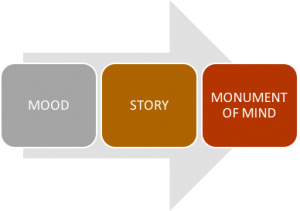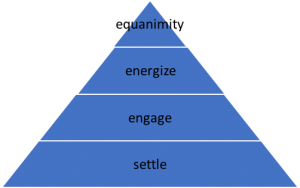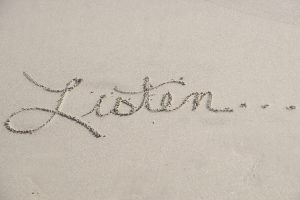Mood Slave: Steps to Freedom by Weatherproofing our Well-being
 Do you ever just wake up in a bad mood? Or someone says something to you that feels unkind and triggers you into a negative state of mind? Maybe you have a propensity toward depression and lose your will, your spirit, your gusto to stay engaged in life in ways that generate your creativity and good habits of health.
Do you ever just wake up in a bad mood? Or someone says something to you that feels unkind and triggers you into a negative state of mind? Maybe you have a propensity toward depression and lose your will, your spirit, your gusto to stay engaged in life in ways that generate your creativity and good habits of health.
Our ‘staying power’ gets compromised, and we give up on our commitments when we get jerked around by our next mood that tells us we’re apathetic, agitated, aversive, and attached to our angst.
It’s a new weather pattern, thickening dark clouds that can convince us there really is no blue sky or changing pallet.
We are trained to stay only in the pleasant, avoid the unpleasant, and ignore the vast in-between. We have a range of habits to avoid what doesn’t feel good that further enslave us in pursuit of something better, which never lasts for long, leading us back to the unattended mood we were running from. We begin to lose confidence in ourselves in this distracted search, sinking into our story which convinces us to conclude, “I am the mood and the mood is me. I will never change, it will never change, they will never change.” When we do this, we’re building a mood into a monument of mind, thought by thought and brick by brick. The mortar thickens with each unknown perception, imagined into interpretation, informing the impulse to indulge in the narrative that constructs the block to our greater intention.
We are all susceptible to this, especially when over-tired, too hungry, too alone, in the middle of protracted periods of high stress like a work deadline, or in any transition, big or small, where we feel uncertain or overwhelmed.
The first step is to know how normal it is to have moods come and go, and the heavier ones will arrive when the conditions make us more vulnerable. We can then begin to understand and be prepared for how we will weatherproof our well-being.
Here are some steps to not be a slave to mood and to find some jewels in the rubble of our monuments of mind:
1. Normalize intense moods. They arise under stress but we don’t need to be mesmerized by them.
2. Settle into the body’s rhythm versus the mind’s construction of story (breath arrives and departs, heart beats – natural intelligence to rely upon.)
3. Set the view again. Gain some perspective to perceive more than just what feels wrong. Intentionally look for what is right, right here. Just like walking across a room and looking from another window, you can see other aspects of the landscape below, changing all the time according to the time of day, season, and the weather patterns. The mood is only a fragment of the landscape of your mind, not the whole of who you are.
4. Engage in investigative inquiry. Hmm, what specifically do I notice in sensation now? What emotion arises? What is that like in my direct experience? What urge/ impulse results from this? Be CURIOUS! Don’t conclude.
5. Energize your determination to direct your attention to this moment to create a new memory, to disrupt the same old same old. Have courage to build wholesome mind states – kind, caring, curious, open. It’s much easier to fall into the pattern of negative thoughts, a well-paved path of our biology to focus on the negative out of protection, but you are more than biology. You have awareness and ability, and it will take some intention and effort to turn toward training more than that automatic reaction.
Find the element of ‘joy’ not based in episodic situations of pleasure, but in the building of your fortitude, your inner compass, the satisfaction in your freedom to choose. Effort is required but let it be the ‘economy of energy’ – not pushing and striving, but balanced with understanding the pain and determining the next movement toward growing wellness. Stand up straighter, engage in some exercise, smile, offer yourself some kindness, decide to walk past the next tantalizing rabbit hole of self-defeating stories. Use your energy to relate kindly to the pain, not pushing it away or fixing it, but giving it more information, redirecting your attention -over and over, just training, just building the momentum of something far more satisfying.
6. Equanimity – This literally means to “stand in the middle.” When we get lost in a mood, we are tilted in one direction. Begin to find what it is you need to ‘put down’ or stop engaging in the mood. You can start to balance the scale by letting go of negative thinking and noting what’s right, right here. For example, when the mood of negativity toward just about everything takes hold, research shows that a dose of loving-kindness practice is the antidote; the two can’t coexist. Embracing loving-kindness can be as simple as offering some understanding to your next experience when you don’t like something. For example, you can respond to your mood with compassion and understanding, e.g., “It makes sense according to the conditions of body, mind, heart – too little sleep, distracted mind, lack of support. I’m caught in habit of negativity.” You can then offer a kind hand toward your new direction of focus.
When we can begin to remember our greater intention – what it is we wish to build in our character toward what end – and let intention reorient our direction, we can be on the lookout for those telltale signs along the path that might pull us down into the detoured route following every other mood.
As you walk the path, the landscape of your mind can be created by your awareness. Notice which Monuments of Mind, constructed from your past memory, are helping or hindering your well-being.
Determine which ones you will pay attention to and which might need some reconstruction. Those then can be broken down and built anew. Just by settling enough in the moment, you can sense the experience of your mood, the thought, the emotion, the physical tension, with care and understanding. With this awareness, you move the mind in a new direction to sculpt a brand new monument as a guidepost on that path to remind you of what supports your long-term well-being.

SEE-E:
S- settle into body & view
E- engage investigative inquiry
E- energize determination, courage, joy, intention
E- equanimity in the middle not pulled by the forces of liking or not liking
Tags: mood boosters, mood swings, moodiness








